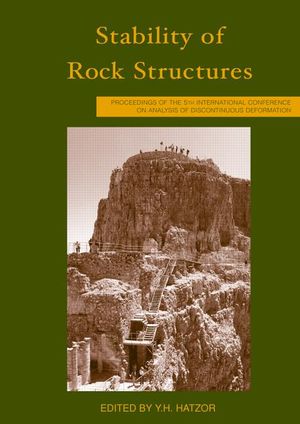ICADD-5 Proceedings
Jump to navigation
Jump to search
Contents
Proceedings of the 5th International Conference on Analysis of Discontinuous Deformation
Stability of Rock Structures
Editors
- Bernard Amadei
Contents
- Single and Multiple Block Limit Equilibrium of Key Block Method and Discontinuous Deformation Analysis. Gen-Hua Shi. pages 3-43.
- Realistic Dynamic Analysis of Jointed Rock Slopes using DDA. Y. H. Hatzor, A. A. Arzi and M. Tsesarsky. pages 47-56.
- Numerical Model for Coupled Thermo-Hydro-Mechanical Processes in Fractured Rocks-Continuum and Discrete Approaches. L. Jing, K.-B. Min and 0. Stephansson. pages 57-67.
- Grand Challenge of Discontinuous Deformation Analysis. A. Munjiza and J. P. Latham. pages 69-73.
- High-Order Manifold Method with Simplex Integration. Ming Lu. pages 75-83.
- Experimental Investigation into Floor Bearing Strength of Jointed and Layered Rock Mass. D. Kumar and S. K. Das. pages 87-93.
- Stability Analysis for Rock Blocks in Three Gorges Project. Wu Aiqing and Huang Zhengjia. pages 95-100.
- Some Approaches on the Prediction of Hillside Stability in Karstic Massif. E. Rocamora Alvarez. pages 101-105.
- Analysis of Displacement and Stress Around a Tunnel. S. Chen, Y.-N. Oh, D.-S. Jeng and L.-K. Chien. pages 107-110.
- A Parametric Study using Discontinuous Deformation Analysis to Model Wave-Induced Seabed Response. Y.-N. Oh, D.-S. Jeng, S. Chen and L.-K. Chien. pages 113-119.
- Simulations of Underground Structures Subjected to Dynamic Loading using the Distinct Element Method. J. P. Morris, L. A. Glenn, F. E. Heuzé and S. C. Blair. pages 121-124.
- Numerical Analysis of Gjøvik Olympic Cavern: A Comparison of Continuous and Discontinuous Results by using Phase$^2$ and DDA. Therese Scheldt, Ming Lu and Arme Myrvang. pages 125-131.
- Earthquake Site Response on Hard Rock - Empirical Study. Y. Zaslavsky, A. Shapira and A. A. Arzi. pages 133-144.
- Numerical Simulation of Shear Sliding Effects at the Connecting Interface of Two Megalithic Column Drums. N. L. Ninis, A. K. Kakaliagos, H. Mouzakis and P. Carydis. pages 145-152.
- On Determining Appropriate Parameters of Mechanical Strength for Numeric Simulation of Building Stones. N. L. Ninis and S. K. Kourkoulis. pages 153-162.
- Experimental Validation of Combined FEM/DEM Simulation of R.C. Beams under Impact Induced Failure. T. Bangash and A. Munjiza. pages 165-169.
- A Study of Wedge Stability using Physical Models, Block Theory and Three-dimensional Discontinuous Deformation Analysis. M. R. Yeung, N. Sun and Q. H. Jiang. pages 171-180.
- Shaking Table Tests of Coarse Granular Materials with Discontinuous Analysis. T. Ishikawa, E. Sekine and Y. Ohnishi. pages 181-187.
- Pre-failure Damage,Time-dependent Creep and Strength Variations of a Brittle Granite. O. Katz and Z. Reches. pages 189-194.
- Dynamic Block Displacement Prediction - Validation of DDA using Analytical Solutions and Shaking Table Experiments. M. Tsesarsky, Y. H. Hatzor and N. Sitar. pages 195-203.
- Crack Propagation Modeling by Numerical Manifold Method. Shuilin Wang and Ming Lu. pages 207-213.
- Continuum Models with Microstructure for Discontinuous Rock Mass. J. Sulem, V. De Gennaro and M. Cerrolaza. pages 215-223.
- Development of a Three-dimensional Discontinuous Deformation Analysis Technique and its Application to Toppling Failure. H. I. Jang and C. I. Lee. pages 225-229.
- Three-dimensional Discontinuity Network Analysis (TDNA) on Rock Mass. Xiao-Chu Peng and Hong-Bo Tang. pages 231-237.
